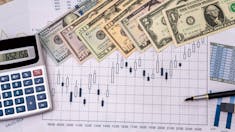What Is Leverage in Forex and CFD Trading? (Updated 2025)
All products and services featured are independently selected by WikiJob. When you register or purchase through links on this page, we may earn a commission.
- A list of the Top Forex and CFD Brokers for January 2025:
- Description of the Best Forex Brokers for January 2025
- Why Is Leverage Used in Forex Trading?
- How Does Leverage Work in the Forex Markets?
empty
empty
- What Are the Risks Involved With Leverage?
- How to Reduce the Risks Associated With Leverage
- Frequently Asked Questions
- Final Thoughts
The use of leverage in forex trading is the process of using borrowed funds to increase your trading position.
Leverage is offered by brokers and allows traders to hold positions beyond the limitations of their cash balance, which can significantly increase their return on investment. It does, however, also increase risk and can amplify losses.
Leverage should be carefully considered and used sensibly. It is important to always employ a solid risk management strategy. Consistent returns should be prioritised over risky trades that have the potential to do financial damage if the market was to move in an unexpected direction.
This article will explore the use of leverage for forex trading in greater detail, particularly regarding the risks involved and how these can be partially mitigated.
A list of the Top Forex and CFD Brokers for January 2025:
Description of the Best Forex Brokers for January 2025
1. Plus500
Pros
- No buy/sell commissions and tight spreads
- Leverage of up to 1:30
- FREE unlimited Demo
- 2,800+ CFD trading instruments
- Real-time quotes and advanced analytical tools
- Fast and reliable order execution
Cons
- No API integrations
- No social copy trading
Plus500 instruments are available for trading exclusively via CFDs and the service offered on the platform is CFD-based.
Another user-friendly entry on our list of the best forex and CFD brokers in the UK is Plus500, providing an easy-to-use and accessible service.
You’ll find over 60 CFD currency pairs with competitive spreads, no commission and available leverage of up to 1:30.
Although MetaTrader and cTrader are not available, Plus500’s own platform is very user-friendly. It comes with a range of intuitive risk management features and is available on web and mobile.
Plus500 requires a minimum deposit of £100 if using a credit or debit card, and £500 if using bank transfer.
Plus500 UK Ltd authorized & regulated by the FCA (#509909).
2. Pepperstone
Pros
- Extensively regulated
- No minimum deposit
- Low fees and mostly free withdrawals
- Good customer service
Cons
- No investor protection for clients outside UK, EU and EEA
- Withdrawal fee for international bank wires
- CFDs only
Pepperstone is consistently ranked among the top forex brokers globally due to its competitive trading conditions, advanced trading platforms, strong regulatory framework, and excellent customer support.
Pepperstone offers some of the tightest spreads in the industry, particularly through its Razor account.
For example, spreads on major currency pairs such as EUR/USD can start as low as 0.0 pips, combined with a low commission of $3.50 per lot per side on the MetaTrader platforms and $3.00 on cTrader. This competitive pricing structure is highly beneficial for both high-frequency traders and scalpers who need to minimize trading costs.
Pepperstone provides leverage up to 1:500 for professional clients, allowing traders to maximize their market exposure with a relatively small initial investment. Retail clients have access to leverage up to 1:30 due to regulatory restrictions, which helps in managing risk while providing ample trading opportunities.
These platforms are renowned for their user-friendly interfaces, advanced charting tools, extensive range of technical indicators, and support for automated trading through Expert Advisors (EAs).
MT5 also offers additional features such as more timeframes, more order types, and an integrated economic calendar, making it a favorite among advanced traders.
Known for its intuitive design and advanced functionalities, cTrader provides features like detailed charting tools, advanced order types, and algorithmic trading capabilities through cTrader Automate. It is particularly suited for traders looking for a professional trading experience.
Pepperstone’s integration with TradingView offers powerful charting tools and access to a large social trading community. This integration is beneficial for traders who rely heavily on technical analysis and peer insights.
Pepperstone offers fast execution speeds, averaging around 30 milliseconds, which is crucial for forex traders who need to enter and exit trades quickly. The broker's deep liquidity pool helps ensure that large orders are executed with minimal slippage, enhancing trading efficiency and effectiveness.
Pepperstone provides essential risk management tools, including stop-loss and take-profit orders, to help traders manage their positions effectively. Negative balance protection is also available, ensuring that traders do not lose more money than they have deposited, which is crucial for maintaining financial stability during volatile market conditions.
3. eToro
Pros
- Regulated by FCA, ASIC
- No withdrawal fee for US clients
- 0% commission on stocks
- Social and copy trading
Cons
- Not available in every US State
- More expensive than most of its competitors
- No MetaTrader platforms
Below content does not apply to US users
Founded in 2007, eToro is considered a very low-risk broker as it is highly regulated by the Financial Conduct Authority (FCA) in the UK and many other regulatory bodies elsewhere.
Opening an account is free and you can access a $100,000 demo account to test the system.
It offers 47 currency pairs for trading. Spreads for forex trading have recently been significantly reduced and range from a very competitive 1 to 3 pips for major currency pairs.
Typical spreads for EURUSD and USDJPY trades, for example, are just 1 pip.
You can see the full list of spreads on the eToro website.
You’ll need to deposit a minimum of $50 for Copy Trading, eToro's standout feature which allows you to follow other traders and copy their trades.
This forex broker is great for beginners due to its user-friendly interface and app and 24-hour customer support. It allows you to trade currencies, stocks and cryptocurrencies in one portfolio and the Copy Trading system is a great way to learn.
The company also offers trading courses and features a Learning Lab which houses a variety of tools to support clients with their trading experience.
To find out more, read our eToro review.
51% of retail investor accounts lose money when trading CFDs with eToro. You should consider whether you understand how CFDs work, and whether you can afford to take the high risk of losing your money.
4. IG
Pros
- Highly regulated
- MetaTrader 4 (MT4)
- Over 10,000 instruments
- Available in the UK and US
- 24/7 customer support
Cons
- High fees
- No deposit compensation scheme for US accounts
- No copy trading
- Inactivity fees
IG is a great share trading platform for beginners thanks to its user-friendly interface and extensive educational resources.
Pros of IG include a wide range of trading instruments and markets, as well as the ability to access multiple account types and trading platforms. The platform also offers a demo account for beginners to practise trading strategies before investing real money.
However, IG isn’t the cheapest share trading platform, with relatively high trading fees and a minimum deposit requirement of £250 when paying by credit/debit card or PayPal.
In terms of additional fees, IG charges a commission fee for share trading, starting from £8 per trade. There’s also a custody fee of 0.25% per year for holdings of £250 or more.
Overall, IG is a solid choice for beginners looking for a user-friendly platform with extensive educational resources, but investors should be aware of its fees and minimum deposit requirements.
5. Saxo
Pros
- Heavily regulated
- Good product portfolio
- Low forex fees
- No withdrawal or inactivity fees
Cons
- Does not accept US clients
- High fees for options, futures and bonds
Saxo offers leverage in Forex and CFD trading, providing traders with the opportunity to potentially increase their exposure and profits from the financial markets using a relatively small amount of capital.
Saxo provides varying levels of leverage depending on the asset class and the specific market conditions. For Forex trading, Saxo typically offers high leverage levels, which can significantly amplify both gains and losses. The leverage for CFDs can vary depending on the type of underlying asset (e.g., stocks, commodities, indices).
Leveraged trading requires traders to maintain a minimum margin, which is a fraction of the position’s total value that must be held in the trading account as collateral. Saxo specifies margin requirements for each financial instrument, and these requirements can change based on market volatility and other factors.
Leveraged trading carries a high level of risk, and Saxo provides several tools to help manage this risk. These include stop-loss orders, which automatically close a position at a specified price to limit potential losses. Saxo also provides risk management education and resources to help traders make informed decisions and develop strategies to manage their exposure effectively.
As a regulated broker, Saxo adheres to strict financial standards and leverage caps imposed by regulatory authorities, such as the Financial Conduct Authority (FCA) in the UK and others around the world. These regulations are designed to protect traders by limiting the maximum leverage offered.
Understanding leverage and its implications is crucial for trading success. Saxo offers educational resources that cover the basics and complexities of leveraged trading, including webinars, articles, and tutorials specifically geared towards Forex and CFD trading.

Why Is Leverage Used in Forex Trading?
In forex trading, investors use leverage to maximise the profits they can make from currency fluctuations.
In the forex market, currency fluctuations are very small pip movements. This means that the profit made on each trade tends to be small, hence the pace of forex trading and the large number of trades required to make a substantial profit.
Note: A pip is the smallest exchange price movement that can occur between a currency pair and stands for ‘percentage in point’.
With the use of leverage, traders can carry out larger currency transactions – opening orders much greater than their capital allows – which can translate price movements into more sizable profits.
Leverage allows forex traders to see increased movements in their accounts as without leverage, movements would be small and dependent upon the capital the trader tangibly has. With leverage, traders could easily see a 10% movement in a day, meaning vastly increased profits.
How Does Leverage Work in the Forex Markets?
When trading in the forex market, traders tend to be able to secure much higher leverage than they would in other markets – the stock market, for example.
To put the high leverage amounts available in the forex market into perspective, a leverage ratio of 2:1 is usually provided in the equities market and 15:1 leverage ratio in the futures market. Leverage in forex tends to be offered at a ratio of 50:1 and above.
Note: 'Equity market' is another term for the stock market. Futures are financial contracts which obligate the buyer/seller to deliver a specified amount of a certain commodity on a certain date. The futures market is an exchange to buy and sell these futures contracts.
The leverage offered in forex is higher because currency prices usually fluctuate less than 1% in an intraday period, meaning that the risk to the lender is less.
The money is usually borrowed from the forex broker who is handling the trader’s forex account. To borrow the money, the trader will need to open a margin account.
While leverage is often defined by traders as a line of credit provided by a broker to their client, leverage does not have the features that come with credit. There is no deadline for settling the leverage provided by the broker and no interest.
A high leverage offer in forex trading means that a trader can control a large amount of money for a comparatively small initial margin requirement.
Note: An initial margin is the percentage of the purchase price of a security that needs to be covered by either cash or collateral when using a margin account.
eToro – Our Favourite Forex Broker
51% of retail investor accounts lose money when trading CFDs with eToro. You should consider whether you understand how CFDs work, and whether you can afford to take the high risk of losing your money.
Unpacking Leverage Ratios
In forex trading, the leverage offered will depend on the broker, the size of the account and the size of the position the trader intends to make.
The leverage will have a minimum deposit in place for use. The leverage provided is usually 50:1, 100:1 or 200:1.
-
50:1 – This leverage ratio means that for every £1 you have, a trade of up to £50 can be placed. This means that for a deposit of £500, you would be able to trade up to £25,000 on the FX market.
-
100:1 – This leverage ratio means that for every £1 in your account, you can place a trade of up to £100. On a standard lot account, this is the typical amount of leverage offered. The minimum deposit tends to be £2,000.
-
200:1 – A leverage ratio of 200:1 means that you can place a trade of up to £200 for every £1 in your trading account. This is the leverage ratio that tends to be offered on a mini lot account. The minimum deposit required is logically lower than that on a standard lot account, with an amount of £300 usually requested.
-
400:1 – A ratio of 400:1 means that for every £1, a trade of up to £400 can be placed. Whilst a ratio of 400:1 is offered by some brokers for mini lot accounts, it should not be offered on small accounts. Trading with a small deposit on a 400:1 ratio could finish your foray into trading in less than five minutes.
It is important to be sensible with the ratios you choose to trade with. You do not need to trade on the highest ratios that brokers offer; you can trade on a more conservative leverage amount by depositing more money and making fewer trades.
Just because the leverage is available, does not mean that you need to or should use it.
Leverage amounts such as 10:1 and 20:1 are most commonly used by professional traders. Experience will teach you when to use leverage and when it is best to avoid it but, as a rule of thumb, the less leverage used the better.
It is better to be cautious and have the capital to trade for longer, rather than wiping out all of your capital resources early on.
An Example of Leverage in Action
When using leverage, a loss can build up rapidly. The example below displays just how easily this can happen:
Trader A and Trader B both have capital of £10,000. Their broker requires a 1% margin deposit.
Scalping analysis indicates that taking a position on GBP/JPY should be profitable, so they short the GBP/JPY at 120 as they believe it is about to fall.
Trader A uses a leverage ratio of 50:1 taking a position sized at £500,000 (50 x £10,000 trading capital).
Trader B is more cautious and applies five times leverage and takes a position of £50,000 (5 x £10,000 initial trading capital).
The short was made at 120.
One pip for one standard lot = approx. £8.30, so one pip movement for the five standard lots = approx. £41.50.
The pip movement goes against these traders and rises to 121
Trader A has lost 100 pips, equivalent to £4,150. This is 41.5% of their total trading capital of £10,000.
Trader B has also lost 100 pips, but due to the lower leverage used this is equivalent to £415 and a loss of only 4.15% of total capital.
If the trade had gone the way the traders had hoped and expected, Trader A would have made substantially more profit than Trader B. Unfortunately, the high leverage used by Trader A made them extremely vulnerable if the trade did not evolve as predicted.
Trader A only has 58.5% of their trading capital remaining, whereas Trader B still has 95.8% of their capital intact. As a consequence, Trader B is in a much stronger position to make a profit going forwards.

What Are the Risks Involved With Leverage?
Leverage provides traders with the opportunity to increase their positions and make significant profits through the ability to fully exploit currency fluctuations. When using leverage, however, traders should be aware that while leverage can amplify gains in forex trading, it also amplifies any losses.
Leverage should be used wisely, alongside a realistic risk management strategy. Much of the risk in trading comes from the amount of leverage on the trade, not the movement of the asset itself.
When making a currency trade with values in excess of £100,000, even small fluctuations can result in huge losses or profits.
Forex traders should be sensible – they should not use all of their available margin, and only employ the use of leverage when the advantage is distinctly on their side.
Professional traders usually trade with very low leverage. Low leverage protects you from the financial impacts of trading mistakes and keeps your gains consistent.
There are certain situations when leverage should not be used; for example, in automated trading. This is the case because less discretion can be used.
Financial agencies and brokerages that offer leverage provide leverage warnings reminding traders about the high risk to their capital.
It is, however, important to remember that, when used correctly, leverage can be an efficient use of capital and its employment greatly widens the scope of the trading an individual can partake in.
How to Reduce the Risks Associated With Leverage
Using leverage to increase your trading position makes you more vulnerable. To reduce risk and control losses, forex traders tend to implement strict controls when trading using leverage by imposing stop-loss orders.
Stop-loss orders protect trades from unexpected market shifts. A stop-loss order is an instruction given to the broker that the trade must be exited when it reaches a certain price. When entering a trade, it is good practice to carefully consider the point at which you will exit and set up a stop-loss order indicating this figure.
Even if traders follow market trends closely, the volatility of the forex market means the protection from a stop-loss order is invaluable in protecting against the accumulation of small losses.
When you use a stop-loss market order to set your stop-loss price, as soon as the price nears your limit, a market order is automatically sent by the broker to close your position at the current price.
It is worth noting that stop-loss market orders differ from a conventional market order. With a market order, a trader outlines that they wish to trade a certain number of shares of a stock at the current market-clearing price. Basic market orders do not allow traders to set an exit price.
Using a stop-loss market order instead allows the investor to specify their limit price.
Depending on the conditions of the market, however, the trade may not be exited at exactly the stop-loss price. This difference is referred to as slippage.
A type of combined order referred to as a stop-loss limit order helps to eradicate losses from slippage. When the specified price is reached, a limit order is sent and the trade is made only at that price or better.
Leverage in forex trading is the use of borrowed funds provided by the broker to open larger positions in the market than what the trader could do with their own capital.
In forex trading, leverage is expressed as a ratio, such as 1:50 or 1:200, which indicates the amount of capital that a trader can control with a certain amount of margin.
Maximum leverage in forex trading is the highest ratio of borrowed funds that a trader can use to open a position in the market.
The maximum leverage is determined by the broker and may vary depending on the account type, the trader's experience, and the regulatory requirements of the country where the broker is located.
Leverage in forex trading allows traders to control larger positions in the market with a smaller amount of margin.
For example, if a trader has a leverage of 1:100 and wants to open a position of $10,000, they only need to deposit $100 as margin. The rest of the $9,900 is borrowed from the broker.
The best leverage for forex trading depends on the trader's experience, risk tolerance and trading strategy.
In general, it is recommended for novice traders to start with lower leverage, such as 1:10 or 1:20, while more experienced traders may use higher leverage up to 1:500.
To use leverage in forex trading, a trader needs to select the desired leverage ratio when opening a position.
The higher the leverage, the less margin is required to open a position. However, it also increases the risk of losses as the position size is larger.
Leverage in forex trading is determined by the broker and may vary depending on the account type and the regulatory requirements.
Traders can usually select the desired leverage ratio when opening a position or adjust it in their account settings.
The maximum leverage offered by the broker is also an important factor to consider when choosing a Forex broker.
When choosing leverage for a live forex trading account, it is important to consider your level of experience, risk tolerance and overall trading strategy.
As a general rule of thumb, it is recommended to start with lower leverage, such as 1:10 or 1:20, if you are new to trading.
More experienced traders may opt for higher leverage, up to the maximum allowed by their broker, but should still exercise caution and only use leverage they can afford to lose.
When trading with leverage, losses can amplify just as gains can amplify. If the market moves against a trader's position, the losses will be magnified by the amount of leverage used.
In extreme cases, losses may even exceed the initial investment.
It is important for traders to manage their risk and use appropriate position sizing to limit their exposure to potential losses.
The main benefit of using leverage in forex trading is the ability to control larger positions with smaller amounts of capital.
This can potentially amplify gains and allow traders to take advantage of market movements that would otherwise not be profitable with their available capital.
However, it is important to note that leverage also increases risk and can lead to larger losses if the market moves against a trader's position.
The best brokers to use leverage in forex trading will vary depending on individual trading needs and preferences.
Some popular forex brokers that offer competitive leverage include IC Markets, Pepperstone and Oanda.
However, it is important to do thorough research and choose a reputable broker that is regulated by a respected financial authority.
The main risk of using leverage in forex trading is the potential for amplified losses. If the market moves against a trader's position, losses will be magnified by the amount of leverage used.
Additionally, high leverage can lead to margin calls, where a trader is required to deposit additional funds to cover losses.
It is important for traders to understand the risks involved with using leverage and to use appropriate risk management techniques to limit their exposure.
Regulations and restrictions on leverage in forex trading vary by country and jurisdiction.
In some regions, there may be limits on the maximum amount of leverage that can be offered by brokers.
For example, in the United States, maximum leverage is capped at 50:1 for major currency pairs and 20:1 for exotic currency pairs.
It is important to check with your broker and local regulatory authority to ensure compliance with any applicable regulations.
Final Thoughts
Using leverage has the potential to magnify the profits a forex trader can make from small market movements. With a low margin requirement, traders can leverage large amounts and make sizable trades that would not have otherwise have been possible.
To be successful and make a profit from forex trading, however, it is vital to use leverage responsibly. Traders must not max out the leverage that they have been offered by their broker.
As it has been stressed, trading with leverage can boost profits but also magnify losses. Due to the high volatility of the forex market, setting a stop loss when trading is highly recommended.
Used sensibly, leverage can be a useful tool to enable efficient use of capital and make enlarged profits. Always remember though, traders should only ever speculate with money that they can afford to lose.
WikiJob does not provide tax, investment or financial services and advice. The information is being presented without consideration of the investment objectives, risk tolerance or financial circumstances of any specific investor and might not be suitable for all investors. Past performance is not indicative of future results. Investing involves risk including the possible loss of principal.



